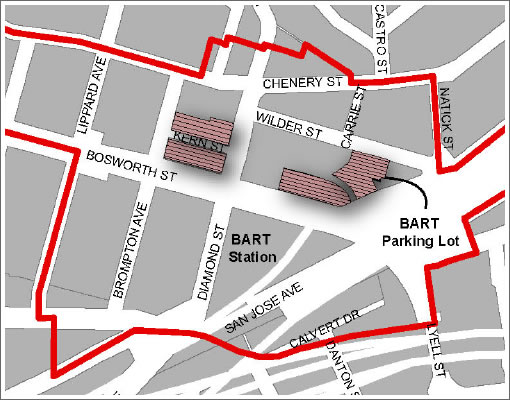
As part of the Glen Park Community Plan the 54-space BART parking lot across from the Glen Park station is proposed to be developed into a mix of ground‐floor commercial along Bosworth, between 40 and 65 residential units in three-story buildings along Bosworth and Arlington, and from “0 to 65” private parking spaces.
And according to the San Francisco Business Times, five developers have thrown their hats into the ring (including a joint venture between Sares Regis and Urban Real Estate Equities (think 74 New Montgomery), EM Johnson Interest (think the Fillmore Heritage Center) and Barry Swenson Builder).
∙ Glen Park Community Plan EIR Notice [SFGov]
∙ Builders vie for Glen Park BART project [San Francisco Business Times]
∙ New Developments: The Montgomery (74 New Montgomery) [SocketSite]
∙ The Heritage On Fillmore (1300 Fillmore) [SocketSite]

Developing that parking lot is a great idea. The area could do with more density in housing given it’s status as a major transit hub in the Bay Area. Retail is also just starting to find it’s feet in Glen Park along Diamond and Chenery but it is coming along. I’m sure there will be opposition by those who don’t won’t the current “sleepy” feel of the hood to change but any development, as long as it is reasonably well executed, is going to be beneficial.
In addition, it never made sense to have BART parking at this location. The parking lot isn’t large enough to handle very many commuters, and the station is not suburban. (It’s the only BART parking lot in San Francisco). Glad to see that something is finally happening with it that is more appropriate for a neighborhood commercial district.
Some of the neighbors are already up in arms, raising the specter of thugs and crime as the consequence of development of that lot. Given that it took nearly 10 years to develop the spot where the Diamond Super burned down…and that was for a library, a small grocery store and only 15 apartments. http://www.spur.org/publications/library/article/howtoturnaparkinglointoapartments05012004
@willow: Since when is Glen Park a major transit hub? What else goes through there? a muni line or two?
It seems to me that developing that lot make sense. but it would also make sense to include a fair amount metered parking for people who are shopping in the area or are making quick BART round trips. The existing lot (which has a 4 hour limit) is generally full or near full, so there is obviously demand for that.
Unfortunately, I expect that the City will says that any parking is inconsistent with “Transit First” so it will veto it. It is too bad, with some intelligent planning, we could make the City greener and more pleasant to live in.
NoeNeighbor – of course the current lot has demand – because the parking is tooooooo cheap there. Add a bunch of metered parking with sane pricing (say $6-10 an hour) and there wouldn’t be the same perceived shortage. When you so heavily subsidize something with limited supply, you run into shortages. If I started selling 50 burritos for a quarter each day and ran out, it wouldn’t mean that there is huge demand for burritos – it means that there is huge demand for 25 cent burritos, enough so that people are probably coming from other areas to get one of mine instead of the appropriately priced ones in their hood. Same goes for this parking.
NoeNeighbor: I’m thinking BART, Muni, 280/101 & the number of company shuttles that run through the area. (i.e. Genetech, Google etc.)
Neighbors in GP are predictably furious about this. Much like today’s Republicans who think health care reform is a one way ticket to Cuban-style communism, some GP residents see this as an attempt to transform GP into a high-density hellhole. They warn that all the open space along Bosworth will be developed with large apartment buildings.
None of this will work without improving the intersection of Diamond and Bosworth. The morning rush there is nearly impassible, with a stoplight intersection, hundreds of people getting dropped off at BART, three bus lines, and numerous corporate shuttle services all cramming into two-to-four lanes.